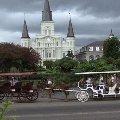Hundreds of people here came for a recent screening of movie director Spike Lee's new documentary, "If God is Willing and Da Creek Don't Rise," a follow up to his film from four years ago "When the Levees Broke." One of the displaced New Orleans residents featured in both films is Phyllis Montana-LeBlanc. "We have come some ways in a lot of areas and in a lot of areas we are still lacking, we are still needing. In my area of New Orleans East we still do not have a hospital five years later," she said. The new mayor of New Orleans, Mitch Landrieu, admits there are still many problems, but he says the city is making a strong comeback. "The thing people need to know about us is that we are still standing and we are still here. We are unbent and un-bowed and the resilience of the people is going to be the thing that resonates for such a long time," she said. Business is brisk in the French Quarter and at other tourist attractions.
The recent oil spill in the Gulf of Mexico caused a temporary dip in restaurant visits, but government inspectors say seafood from the Gulf is now safe to eat.
At the New Orleans Metropolitan Convention and Visitors Bureau, Kelly Shulz says the city is still on track to reach close to pre-Katrina levels of tourist visits. "We are having a fantastic year. When the oil spill happened we wanted to continue that fantastic year, we wanted to continue the momentum. So, although there has not been any oil in New Orleans, we have worked really hard to get the message out that all of the things visitors come to enjoy in New Orleans are unaffected," she said. French Quarter restaurant owner and hot sauce merchant Andrew Engolio says he is seeing a strong recovery. "I do think business is really thriving in the French Quarter. I think it is doing better than even before Katrina, which is wonderful. We thank all the people who are coming from out of town, all the tourists. It is really helpful," he said. City planners say post-Katrina New Orleans still counts on a number of strong assets beyond its tourist attractions, including its active port and its many oil and gas operations.
But there are parts of the city where recovery is much slower, where empty concrete slabs in overgrown lots mark where houses once stood.
In the lower Ninth Ward, where many middle-income African-Americans once lived, Katrina's destruction is still evident. Dolores Wells and her son are trying to restore and protect this home, but local criminals are making it difficult.
Someone recently broke into her house to steal copper wiring and she now questions why anyone would return here. "People don't come back for the same reasons I want to leave and the main ones are corruption in government and crime, street crime, drugs," she said. A recent poll showed crime is the number one concern of most city residents and many areas remain blighted. Both government and private funds support rebuilding projects here, like these flood-resistant houses.
But Dolores Wells says bureaucratic delays have blocked her plans to renovate a couple of nearby houses to use as rental properties, after both she and her son invested their own money. "I took some of my retirement money, which I could ill afford to do and we thought we could rent them out to get some income and we could do this... I am very, very discouraged. I am really discouraged," she said. Five years after Katrina, New Orleans is a mixed picture, with signs of progress as well as stories of heartbreaking struggles.

